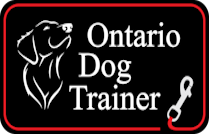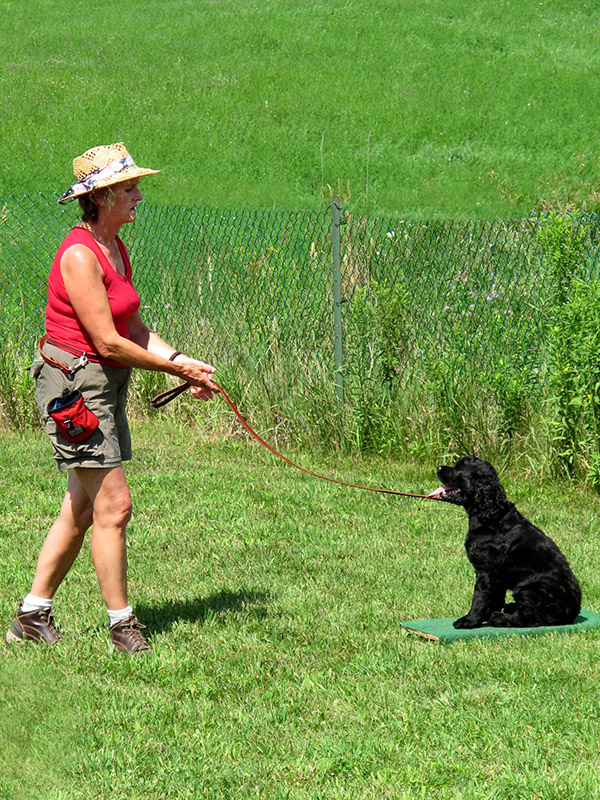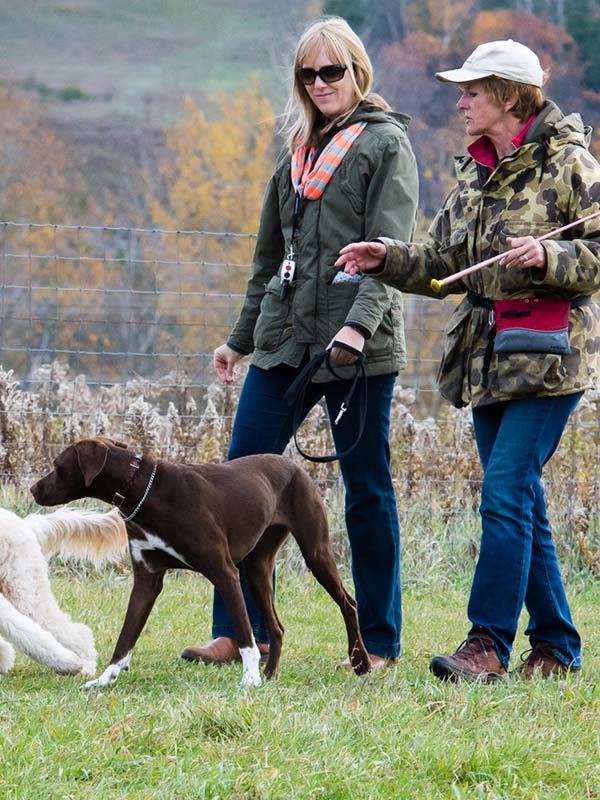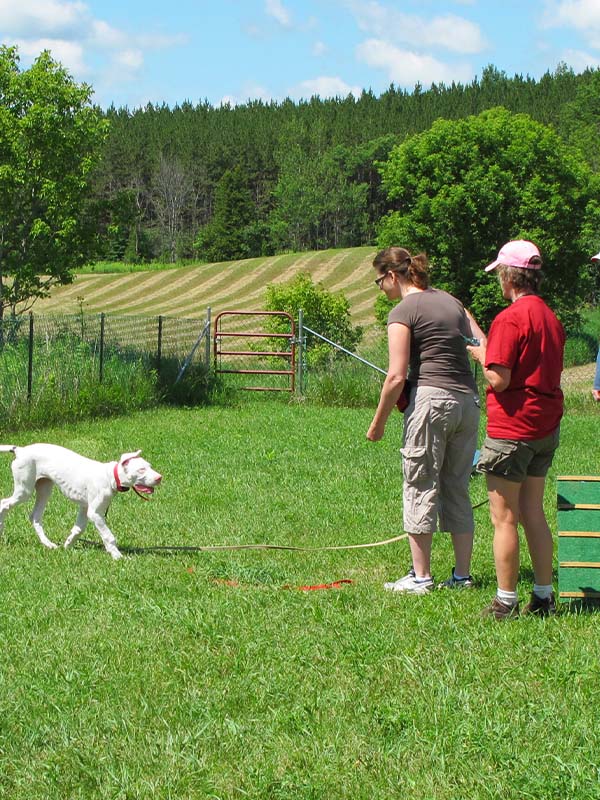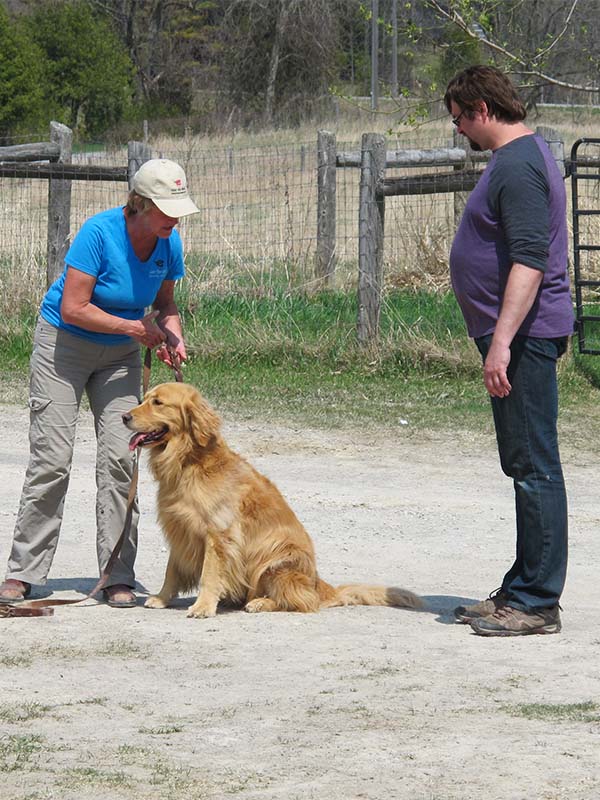Karen’s Biography
I have been working with dogs in some capacity since I was a child. My first mentor was my Dad who taught me to trust a dog’s instinct – especially one who is bred to perform a specific task. “When you trust a dog to do a job it is bred for, you will not be disappointed”. He lived by that philosophy with his hounds and we enjoyed many memorable rabbit hunting trips together. However, he also lived with a ‘human-centric’ focus on how a dog should co-exist with humans. He would never address my question about why our hounds could hunt game for us, hang out with us at the cottage every summer, yet were chained in the backyard for the rest of the year, without enrichment or human engagement.
In the mid-1980’s I acquired my first field trial prospect – a beautiful yellow Lab pup with a ton of potential and I knew I needed help for us to reach our full potential. Using old-fashioned research and communications techniques (telephone and snail mail) I connected with my first dog-training mentor – the late Cassandra (Sanna) Carey of Lakeridge Kennels in Aiken South Carolina. She was the owner of the Field Champion sire of my pup (FC Lakeridge’s Charlemagne) and had achieved recognition as highest scoring Retriever/handler team in the U.S. in the year that I got my pup. Sanna willingly took me on as her student and was very generous with her time, her wisdom and her resources. I loved her like a mother and we worked together for many years until illness stole her brilliant mind. She was the first person to show me what ‘chunking’ and ‘conditioning’ actually looked like. I learned the value of breaking complex concepts into small chunks and repeating each one just enough to provide clarity and to motivate the dog without grinding him down. I was hooked.
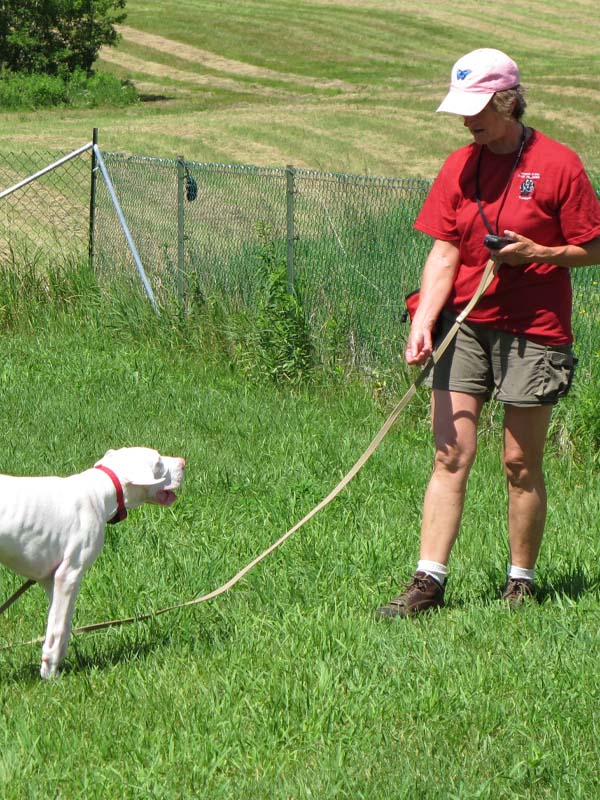
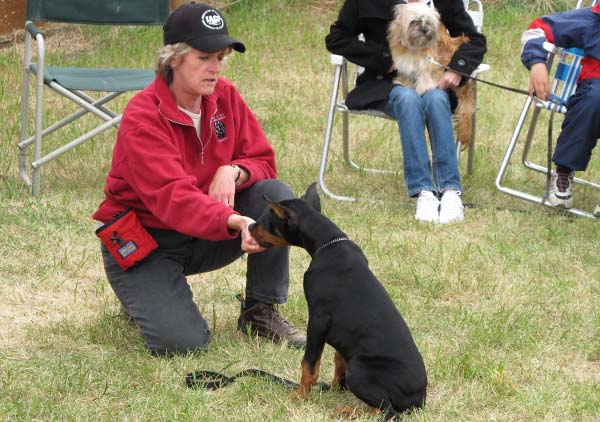
At home in Ontario I lived in the north where training grounds were plentiful but trustworthy mentorship was scarce. I spent many weekends travelling great distances to work with others willing to share their knowledge with me, notably Dennis Voigt author of Retrievers Online and Lorne Langevin. Both were and are top field trial performers. At my home I hosted trainers who were travelling and competing on the ‘northern’ field trial circuit. With all who were willing to share with me, I offered to work by throwing birds, and whatever was needed to be involved in their world. I was like a sponge. I listened to every word, sat in the field throwing birds for hours while watching each dog solve the problem of finding the bird by using its nose, eyes and body movement to read the terrain, utilize the wind and work its way to the ultimate prize. I made copious notes, asked endless questions and read every book that I could get my hands on. Each trainer willingly shared their wisdom, experience, training drills and concepts that enabled me to train my competition dogs to full Field championship titles.
During my years of living with and training Retrievers for competitive field work, (1985-2000), I had a much different perspective than my father on how dogs should live and work with humans. My dogs lived in the house. Even though they were ‘bred to retrieve’ I spent much effort showing my dog what I expected. I believed that my intervention was essential to get an optimum performance from my dog so that we could ‘win’ the next competition. I didn’t really think about how my dog’s brain worked or how he felt about my ‘involvement’ in the process. It felt magical to me when I could blow a whistle when my dog was 300 yards away and he would instantly stop running; turn around to look at me and would sit to wait for further direction. With a flick of my wrist or a slight body movement, he would turn and continue on to his destination in the exact direction that I had indicated, as if I had whispered in his ear. In reality, his response was the product of good breeding and more importantly the accumulation of hours and hours of repeated practice that focused on providing clarity for success that created absolute trust and teamwork. I trusted that my dog would ‘read’ my request and he trusted me to show him a safe way to reach his prize. I never took such trust for granted.
I learned how to set up challenging field-training concepts through reading books and watching others. When working with my local training club, I was often at odds with those who ‘ran’ the group training sessions because I wanted to build a set up by breaking each concept down into small steps to create clarity, build confidence and earn trust with my dog. I wanted to teach in a way that the dog could easily learn from its failure and train for success. The ‘old boys’ wanted to push the uninformed dog into a major testing scenario that immediately set the dog up for failure. Their response was to punish the dog, often long after the failed attempt, for what they deemed to be ‘stubbornness’. In addition to a major difference in training philosophy, I was at odds with the ‘group’ because my approach to living with a working dog was ‘different’. My dogs lived in the house and spent most of their time out of crates, sleeping beside me at night and travelling to work and other places with me during the day to take advantage of any small block of time that allowed ‘training’ to occur. Their dogs lived in kennels or on chains, often in deplorable conditions. I spent most of my time at our club training sessions watching others do to their dogs what I refused to do. In those days, bullying did not have the profile that it has today. However, in terms of dog training and as the only woman among male dog trainers, I was bullied. I was told in no uncertain terms that I did not know what I was doing and because of my lack of skill and knowledge and unwillingness to “do what I was told” my dogs would never amount to anything. They believed that in order for a dog to ‘work for you’ it must be “afraid of you.” I refused to accept such an archaic approach and set out to prove them wrong – which I subsequently did by producing numerous field trial champions year after year, while they produced none … not one … ever.
By the time I moved to a new location in the late 1990’s, the field ‘game’ as I had known it was changing in a way that did not fit with my values. I no longer had an appetite to win at the expense of the dog’s efforts. I just didn’t ‘get’ that dogs were labelled as ‘failures’ if they could not navigate some artificial set up and find a bird faster than another dog. I was finally seeing that this sport was no longer a measure of what I wanted from or with my dogs.
Once I left the competitive training world I was able to ‘step back’ from the pressure of ‘winning’ at all costs. I learned the importance of ‘listening’ to what the dog was telling me. I learned about some guy named Cesar Millan, who was relatively unknown in Canada at that time. My husband showed me an article written in National Geographic about Cesar and said, “there is nothing in this article that has any value for training dogs.” I read the article and my mind was blown! Cesar discussed the fulfillment factor through a balance of exercise-discipline and affection. He discussed human body posture in the context of how a dog feels when approached, how they perceive eye contact, the confusion caused to the dog by human verbal diarrhea, how they read a situation by scent and so much more! I felt that I could see inside the mind of a dog … and I wanted to learn more about why dogs did what they did and how I could influence their success to live better lives with humans . . . and so my journey down a relatively new but similar path began … and continues to this day.
I first read about the 10000 hour rule in a book by Malcolm Gladwell, (Outliers (2008)). In it he references the rise to fame of the famous band The Beatles and how they played for years every weekend for eight continuous hours per day to largely empty pubs. They were either consciously or otherwise developing expertise. By the time they became ‘instant stars’, they had exceeded the criteria to achieve ‘expertise’ according to the 10000 rule. In his book ‘The Talent Code (2009), Daniel Coyle, cites from K. Anders Ericsson et al., June 2006, (The 10000 Hour Rule: The Cambridge Handbook of Expertise and Expert Performance), “every expert in every field is the result of around ten thousand hours of committed practice”. I was intrigued by the concept and by what was happening in the human brain during the 10000 hours. I had never considered myself as an ‘expert’. Yet, when I added up my countless hours over my years of training field dogs, I realized that I had been ‘practicing’ my passion for much more than 10000 hours.
I knew that regardless of my level of expertise, I could learn more and better ways to do things with and for dogs. When I transitioned from competitive field retriever training to companion dog training, I felt I was starting over. I immediately experienced the huge disconnect between motivating a purpose-bred Retriever to perform in a way that it was genetically programmed to do, and gaining the trust and respect of the over-indulged, often non-descript but lovable pet dog with no interest in or use for humans. I was intrigued to take on this new challenge in whatever way was necessary.
Albert Einstein said, “a problem cannot be solved with the same level of thinking that you had when you encountered the problem.” My dog-training mind was firmly entrenched in the principles and approaches of performance dog training – specifically field trial competition training.
I needed a different level of thinking to learn how to motivate pet dogs to learn so that their behaviour could be enhanced or transformed to meet their owners lifestyle needs. I felt like a rookie in the realm of companion dog training. In keeping with Ericsson’s criteria for expertise, I set out to ‘catch up’ and sought mentors who through committed practice and an authentic and credible record of success, have accumulated much more that 10,000 hours learning with and from dogs and other trainers in various disciplines from pet dogs to protection/detection dogs. As with field dog training, if I am to be the best, I aim to learn from the best.
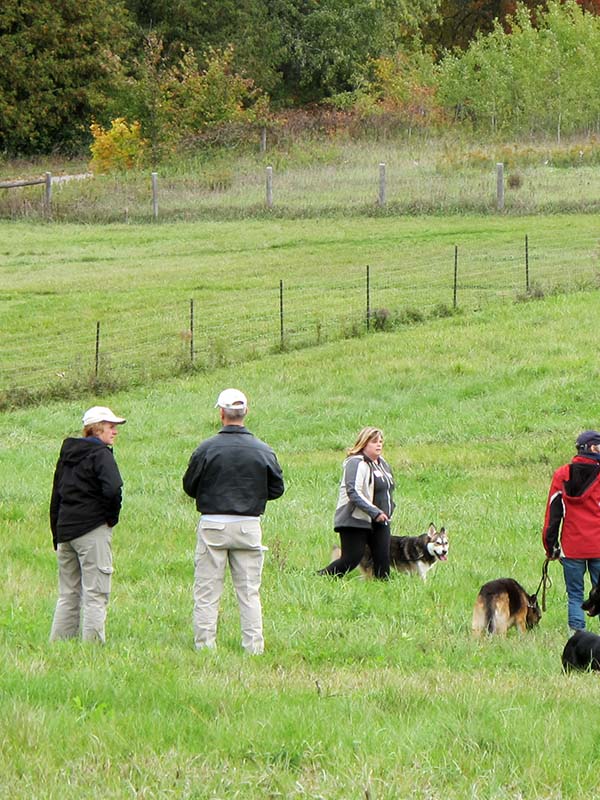
To be a great teacher, one must be a great student.
I realized that every trainer/mentor has learned from someone else. No one ‘owns’ any of the information they have acquired. They may nurture it but not own it. True expertise and power is recognized in the sharing of information for the benefit of others. My transition from competitive field dog training to pet dog training highlighted the importance of reaching out and seeking authentic mentorship from those whom I respected and who understood that true influence lies with sharing, not owning relevant information. I have been extremely fortunate to learn with many great mentors – each has resonated with me and in some significant way has shaped, and continues to influence my ever evolving training philosophy, approach and mindset as well as my appetite for learning and growing as a canine professional.
As my student, mentee or client you may hear and feel the heart and words of my mentors and those who have influenced my work, reflected in my teaching. I am grateful to those who so generously share for the benefit of dogs and their humans. I am humbled to be accepted into your company.
The following are tributes to and excerpts from my most memorable mentors and influencers who have contributed to my ongoing journey to serve dogs and their owners to the very best of my ability. Their messages resonate with me at the loudest level:
Cesar Millan
Cesar Millan, for having the courage to stand up for dogs in a different way and for working tirelessly to change how humans perceive and live with dogs.
Marc Goldberg
Marc Goldberg, for teaching me that “Force Free” is all about freedom and is not about ‘force’ at all and for reminding me that above all else, as professionals, we are in the relationship business. #letdogsbedogs.
Nelson Hodges
Nelson Hodges, for preaching ‘influence not control’ is what builds a human-canine bond, and forever changing the way I interpret dog behaviour and my relationship with dogs. “Don’t fuss with the dog!”
Larry Krohn
Larry Krohn, for generously sharing his ‘relationship first’ wisdom for the benefit of dogs, owners and trainers – “Real training is 10% trainer and 90% owner. It’s not how you train your dog it’s how you live with it. When the relationship is solid, the training can begin.” Applying Larry’s philosophy has deepened my connection with my human clients to enable them to understand how their dog perceives them and to see themselves in the eyes of their dog.
Martin Deeley
The late Martin Deeley, for his belief in me and for bridging the gap between field dog training and humane, effective pet dog training. I continue to embrace his signature e-touch approach of ‘tap on the shoulder’ and principles that always give ‘benefit of the doubt to the dog’.
Chad Mackin
Chad Mackin, for his persistent deep thinking that reminds me to examine every concept, thought and idea from a multitude of perspectives; of the importance of thinking about every move from the dog’s perspective; for introducing me to large field socialization in small spaces and to the concept of ‘pressure-release’ for respectful leash conversation with dogs.
Kayce Cover
Kayce Cover, for introducing me to perception modification, conditioned relaxation and the value of bridge and target training to enhance a dog’s confidence in a human world.
Behesha Doan
Behesha Doan, of This Able Veteran Academy for articulating everything that I have ever learned into one simple opening statement: “If dogs could speak they would say – Lend me your eyes and I will change what you see.” I realized without realizing it, that I had been working within that concept with everything that I have ever done or learned with every dog. Behesha’s mentorship opened my eyes to the realization that ‘talking’ dog,’ ‘thinking like a dog;’ moving ‘like a dog’; ‘being the Pack Leader’ and ‘knowing dogs’ is truly to “see the world through a Dog’s eyes” thus enabling a deeper connection than could ever happen without that vision.
But WAIT! … There’s More?! My passion to learn, grow and improve as a canine professional will continue for as long as I am able. My mentorship journey will expand in 2020 to include attending the schools of NePoPo® with Bart and Michael Bellon, and learning with Linda Kaim to de-mystify puppies. Learning from these experts, I know that magic will continue to happen and enhanced ignition is inevitable.
About Ontario Dog Trainer
At Ontario Dog Trainer we focus on building a bond with your dog before the real work begins.
